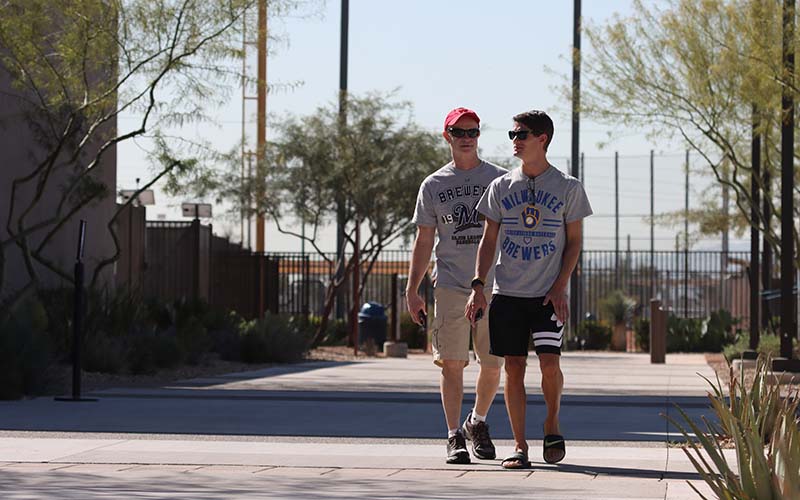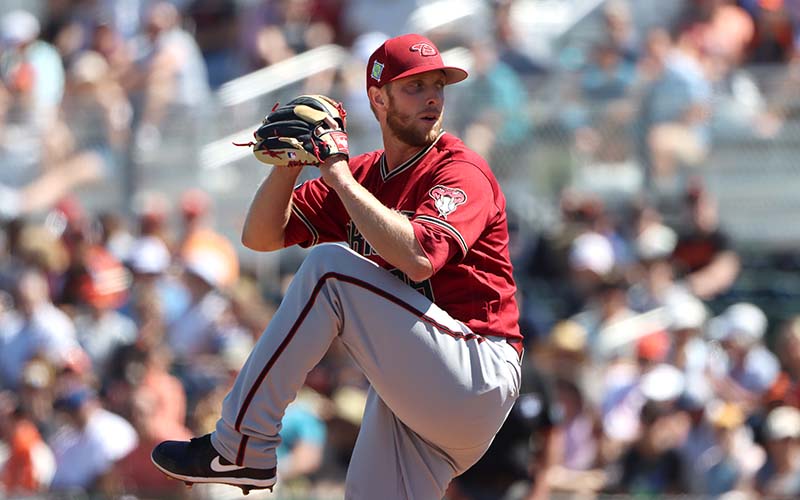
Diamondbacks pitcher, Merrill Kelly, who struck out eight batters in three perfect innings in a recent game against the Giants, is one of the players fan will see once the season starts. (Photo by Amanda Valle/Cronkite News)
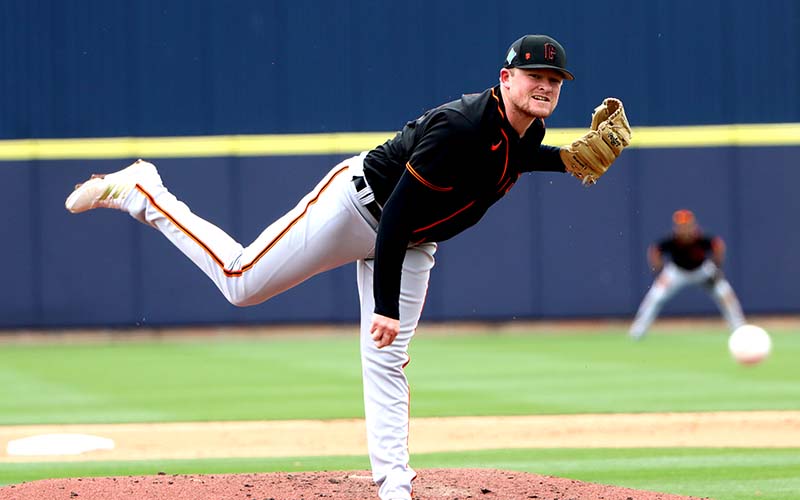
Right-handed pitcher Logan Webb and the San Francisco Giants open the season Friday against the Florida Marlins at Oracle Park. (Photo by Amanda Valle/Cronkite News)
PHOENIX – For most of baseball’s offseason, San Francisco Giants pitcher Alex Wood and many of his contemporaries didn’t have a face.
Literally.
When MLB locked out its players on December 2, the names and faces of players were stripped from any league-sanctioned online presence, including rosters, websites and social media.
During baseball’s longest winter in 27 years, Commissioner Rob Manfred and Tony Clark, head of the MLB Players Association, served as the unwanted faces of the game. The uncertainty of negotiations and the possibility of a lost season was difficult for players and fans alike.
Now, Opening Day is two days away but while that collective bargaining battle has ended, the labor war could wage on.
“Where we’re at is just part of the process. You’re not going to make historical gains in a single (collective bargaining agreement),” Wood said. “We did a lot of things that are really important. We didn’t get a perfect deal, but we fought our way back towards a fair agreement.”
When the CBA officially ended, many expected a swift and civil discourse to take place, leading to the inking of a new deal before the calendar flipped to 2022. That optimistic outlook soon gave way to the ugly reality of a labor lockout.
A months-long slap fight ensued, with an armada of financially savvy players negotiating with the league’s owners to come to an agreement. What was initially supposed to be figured out before the New Year soon bled deep into January.
As fans grew more and more weary of the owners’ tactics, spring training was axed, and six precious regular season games were swept away with it. An agreement was finally reached March 12, and players reported to their respective camps later that week. The six canceled games are being made up during the season, thus avoiding the public relations disaster of a shortened season.
“At the end of the day there’s no games missed, and we’re out here,” Wood said. “But this is really just the beginning.”
The lifespan of a major league CBA is five years, with the negotiating period ideally taking place during the fourth and fifth seasons of a pact. The problem with this frequent re-hashing of terms is that deals rarely become ingrained enough to win over players. Negotiations for the next CBA often begin before the true ripple effects of the current one can be felt.
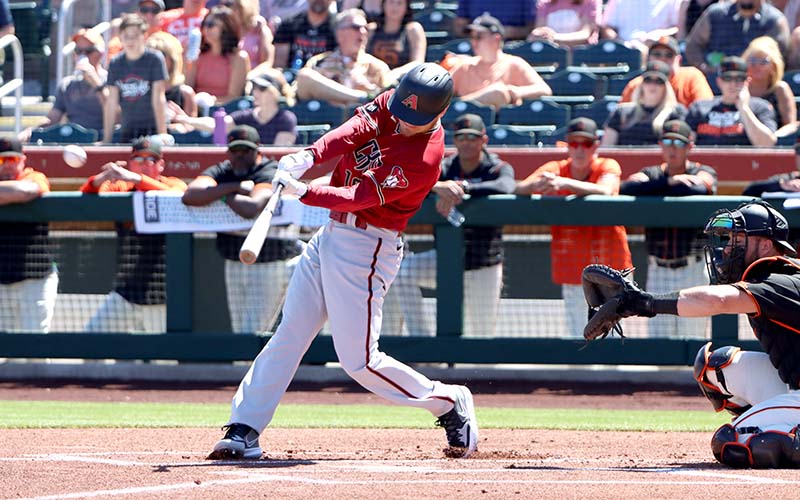
Arizona Diamondbacks second baseman Josh VanMeter hits a fly ball during the abbreviated Cactus League season. Although players are happy to be back, some still feel work needs to be done after the lockout. (Photo by Amanda Valle/Cronkite News)
“You really don’t know how good or bad a deal will be for at least a few years,” Giants pitcher Alex Cobb said. “This was us fighting for fairness, not even for the big leaguers but for younger players and guys in the minors.”
Unlike the strike that ended the 1994 season, the 2022 lockout played out in the social media age. Players were able to voice their opinions on Twitter and Instagram, without having to seek out a surrogate party. The resulting free flow of information allowed fans to form more educated opinions, which likely led to a more sympathetic viewpoint of the players’ side of the conflict.
“I think fans knew a lot more this time around than they did (in 1994) and I hope that will show up in attendance in a couple weeks,” Cobb said. “I can’t wait to get out there. I’ve played in San Francisco a couple times as a visitor, and it’s always a great atmosphere.”
Some players followed the negotiations more closely than others. While fans spent their early spring days refreshing news feeds and hanging on every morsel of information, many players tuned out the noise and opted to enjoy the extended offseason without the constant stress of a never-ending news cycle.
“Probably not as closely as you were,” said Diamondbacks pitcher Madison Bumgarner when he was asked how closely he was following the proceedings. “We don’t have great WiFi or cell service where I am.”
Others were as involved as was possible without being at the table themselves. Wood falls under this category, as his jovially faceless Twitter profile was a frequent contributor to online discourse surrounding the lockout. He felt it was important to relay to the public that the players believed the owners were negotiating in bad faith when the players were determined to get a deal done in a timely fashion.
On March 1, Wood sent a critical tweet regarding the spin from the commissioner’s office.
“FWIW (For what it’s worth) MLB has pumped to the media last night & today that there’s momentum toward a deal,” Wood said in the tweet. “Now saying the player’s tone has changed, so if a deal isn’t done today it’s our fault. This isn’t a coincidence. We’ve had the same tone all along, we just want a fair deal/to play ball.”
FWIW MLB has pumped to the media last night & today that there’s momentum toward a deal. Now saying the players tone has changed. So if a deal isn’t done today it’s our fault. This isn’t a coincidence. We’ve had the same tone all along. We just want a fair deal/to play ball.
— Alex Wood (@Awood45) March 1, 2022
Wood’s teammate LaMonte Wade Jr. is a glass-half-full kind of guy. He used the uncertain offseason timeline to his advantage, focusing on certain aspects of his game that would otherwise be left out if he were ramping up for a February report date in a normal year.
“In some ways the lockout was a helpful tool to me because it allowed me to make adjustments in my swing that were really acute,” Wade said. “We all kind of kept up with things; we have a team group chat and everything. We’re just concentrating on the preparation we can put in now.”
There are two sides to every story, and while the owners certainly took on the villain role over the winter, a number of them were unhappy with the proceedings and wanted a timely deal. The public image of the owners and Manfred took a significant hit, adding to the negative feelings fans already had for the commissioner following the Houston Astros cheating scandal and a lack of action taken by Manfred against Astros players who were involved in it.
Milwaukee Brewers owner Mark Attanasio feels that Major League Baseball’s owners need to take more accountability in order to avoid situations like this in the future.
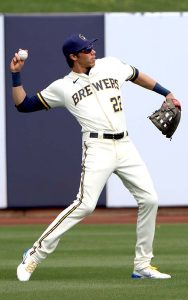
Milwaukee Brewers outfielder Christian Yelich feels confident this spring, and is hitting .267 with three runs and three RBI over 30 at-bats. (Photo by Amanda Valle/Cronkite News)
“We’ve got to do better on our side, I’ll start there,” Attanasio said. “We’ve got to do better at not having a skirmish every five years, that’s been my focus. The most important relationship we all have is with the fans. If we don’t have the fans we don’t have a game. I think everybody is really happy to be back. Based on our early ticket sales, the fans are really happy that we’re back, too.”
Players and fans are certainly relieved that all 162 games will be played this season, but the sport is not yet out of the woods when it comes to labor negotiations. The same issues that led to this lockout may very well lead to another.
“I don’t see anything changing with the next CBA, or the next,” Wood said. “Five or 10 years down the road there will probably still be the same contention.”

